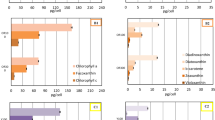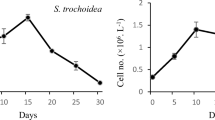Summary
Photoprotective and photosynthetic roles of carotenoid pigments (xanthophylls and β-carotene) were examined in the major bloom forming blue-green algal (cyanobacterial) genera, Anabaena, Aphanizomenon and Microcystis. Since these genera often reside as scums in surface waters, attention was given to the ability of carotenoids to counter potential photooxidation due to maximum near U.V. and visible radiation as well as O2 supersaturation, characterizing surface waters supporting blooms. In U.V.-transparent quartz incubation flasks it was shown that inhibition of carotenoid synthesis by diphenylamine led to rapid photooxidation among the above genera. When carotenoid synthesis was allowed to proceed, a high degree of resistance to photooxidation resulted. Prolonged exposure to near U.V. irradiation led to enhanced carotenoid synthesis relative to chlorophyll a, which extended viability. Carotenoid enhancement also increased chlorophyll a-specific photosynthetic O2 production. It is concluded that enhanced carotenoid synthesis observed during blooms serves at least two ecological functions, i) providing photoprotection and ii) increasing photosynthetic performance of surface cyanobacterial populations.
Similar content being viewed by others
References
Abeliovich A, Shilo M (1972) Photooxidative death in blue-green algae. J Bacteriol 110:682–689
Booker MJ, Walsby AE (1981) Bloom formation and stratification by a a planktonic blue-green alga in an experimental water column. Br Phycol J 16:1–11
Buckley CE, Houghton JR (1976) A study of the effects of near U.V. radiation on the pigmentation of the blue-green alga Gloeocapsa alpicola. Arch Microbiol 107:93–97
Burnison BK (1980) Modified DMSO extraction for chlorophyll analysis of phytoplankton. Can J Fish Aquat Sci 37:727–733
Chu SP (1942) The influence of the mineral composition of the medium on the growth of planktonic algae. 1. Methods and culture media. J Ecol 31:109–148
Clayton RK (1980) Photosynthesis: Physical mechanisms and chemical patterns. Cambridge. University Press, London p 281
Cohen-Bazire G, Stanier RY (1958) Inhibition of carotenoid synthesis in photosynthetic bacteria. Nature 181:250–252
Dinsdale MT, Walsby AE (1972) The interrelations of cell turgor pressure, gas vacuolation and buoyancy in a blue-gree alga. J Exp Bot 23:561–570
Eloff JN, Steinitz Y, Shilo M (1976) Photooxidation of cyanobacteria in natural conditions. Appl Environ Microbiol 31:119–126
Fogg GE, Stewart WDP, Fay P, Walsby AE (1973) The blue-algae. Academic Press
Foy RH, Gibson CE (1982) Photosynthetic characteristics of planktonic blue-green algae: The responses of twenty strains grown under high and low light. Br Phycol J 17:169–182
Fuller RC, Anderson IC (1958) Suppression of carotenoid synthesis and its effect on activity of photosynthetic bacterial chromatophores. Nature 181:252–254
Goodwin TW (1980) The biochemistry of the carotenoids. Chapman and Hall, London. p 377
Goodwin TW, Osman HG (1953) Carotenoid synthesis in Rhodopseudomonas rubrum. G Biochem J 53:541–545
Jeffrey SW (1974) Profiles of photosynthetic pigments in the ocean using thin-layer chromatography. Mar Biol 26:101–110
Jeffrey SW (1981) An improved thin-layer chromatographic technique for marine pigments. Limnol Oceanogr 26:191–197
Kellar PE, Paerl HW (1980) Physiological adaptations in response to environmental stress during an N2-fixing Anabaena bloom. Appl Environ Microbiol 40:587–595
Paerl HW, Ustach JF (1982) Blue-green algal scums: An explanation for their occurrence during freshwater blooms. Limnol Oceanogr 21:212–217
Paerl HW, Tucker J, Bland PT (1983) Carotenoid enhancement and its role in maintaining blue-green algal (Microcystis aeruginosa) surface blooms. Limnol Oceanogr 28:847–857
Parker D (1982) Improved procedures for the cloning and purification of Microcystis cultures. J Phycol 18:471–477
Reynolds CS, Walsby AE (1975) Water blooms. Biol Rev 50:437–481
Stransky H, Hager A (1970) Das Carotenoidmuster und die Verbreitung des lichtinduzierten Xanthophyllcyclus in verschiedenen Algenklassen. IV. Cyanophyceae und Rhodophyceae. Arch Mikrobiol 72:84–96
Walsby AE (1972) Structure and function of gas vacuoles. Bact Rev 36:1–32
Walsby AE, Booker MJ (1980) Changes in buoyancy of a planktonic blue-green alga in response to light intensity. Br Phycol J 15:311–319
Author information
Authors and Affiliations
Rights and permissions
About this article
Cite this article
Paerl, H.W. Cyanobacterial carotenoids: their roles in maintaining optimal photosynthetic production among aquatic bloom forming genera. Oecologia 61, 143–149 (1984). https://doi.org/10.1007/BF00396752
Received:
Issue Date:
DOI: https://doi.org/10.1007/BF00396752




